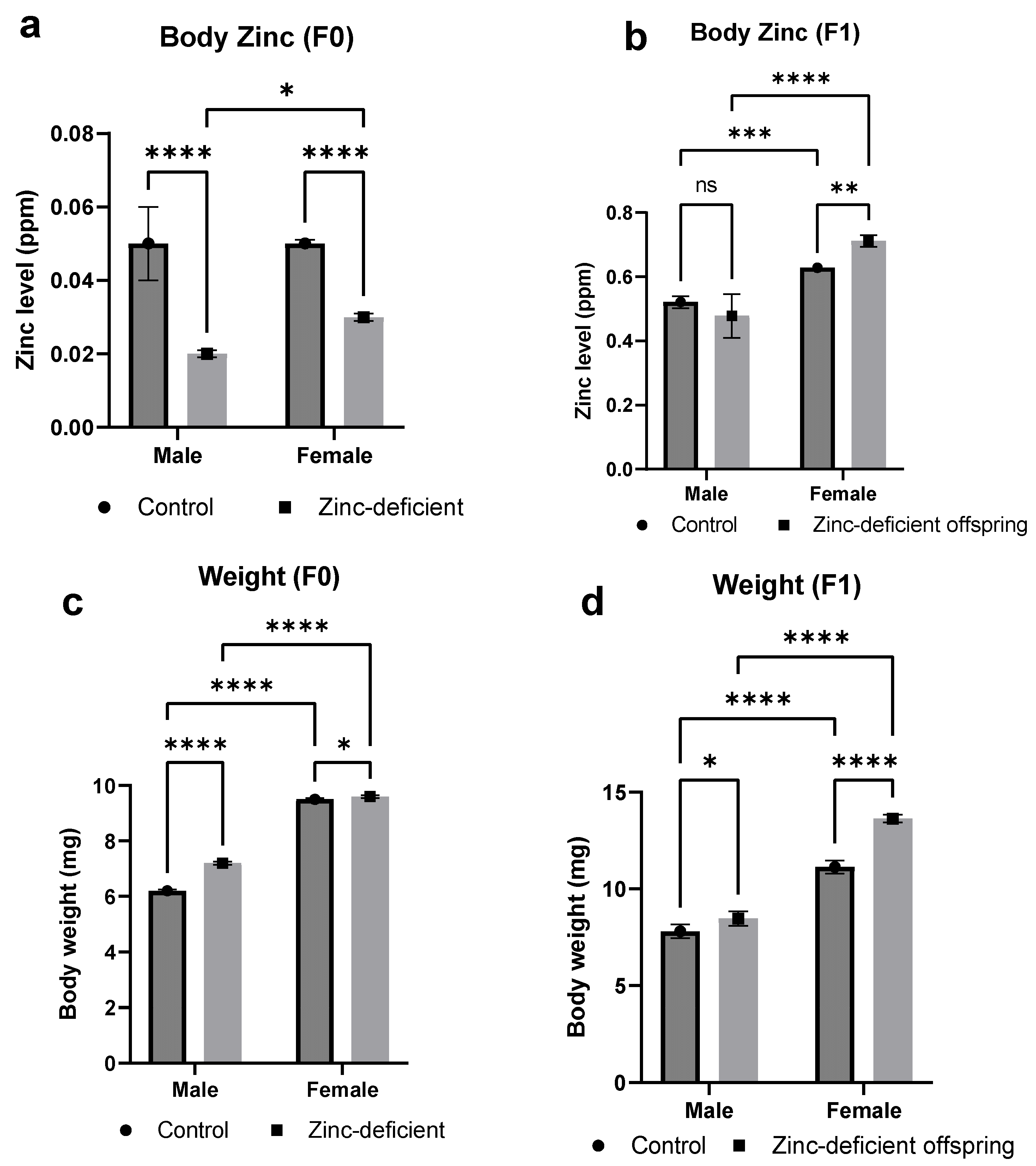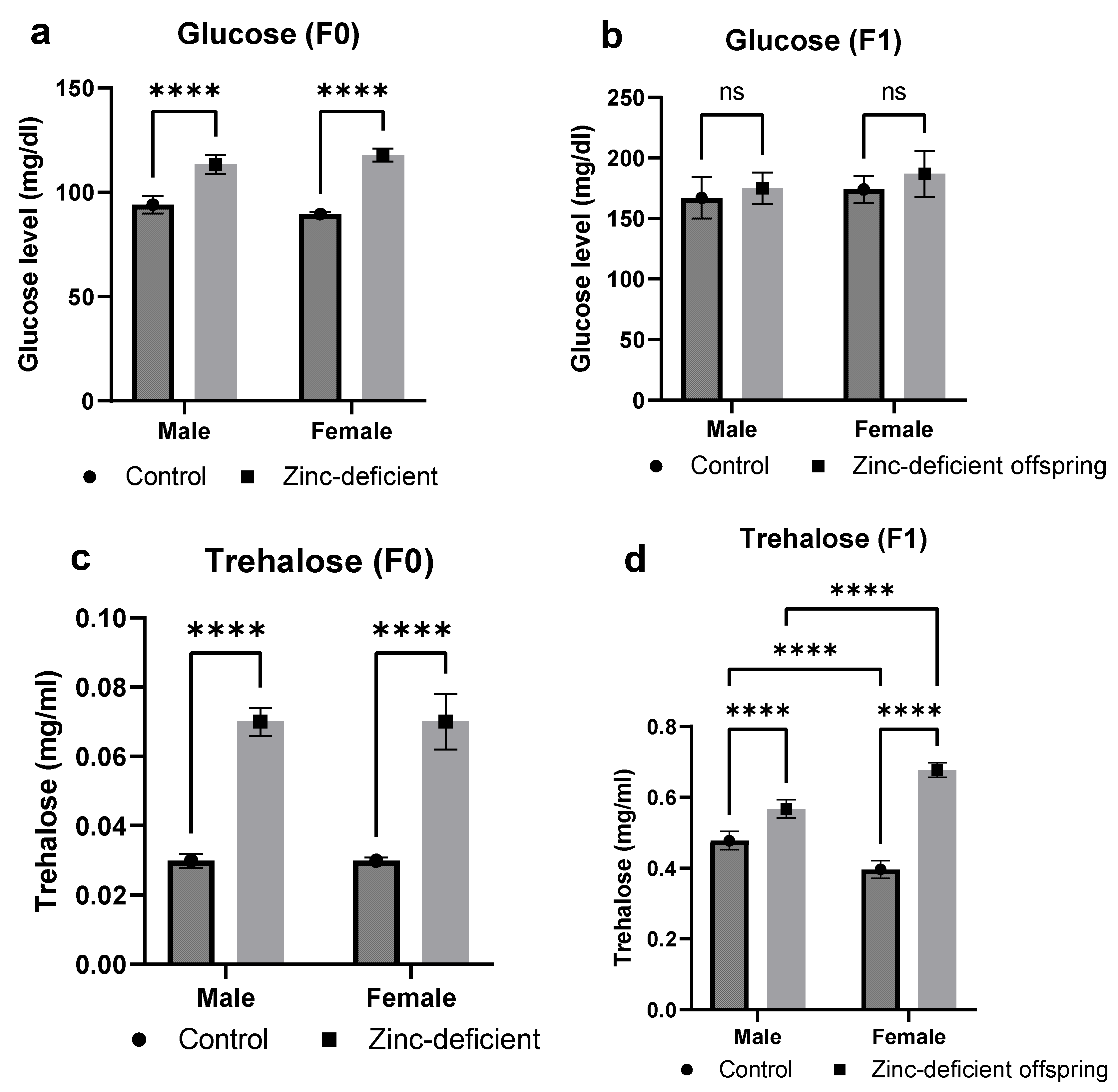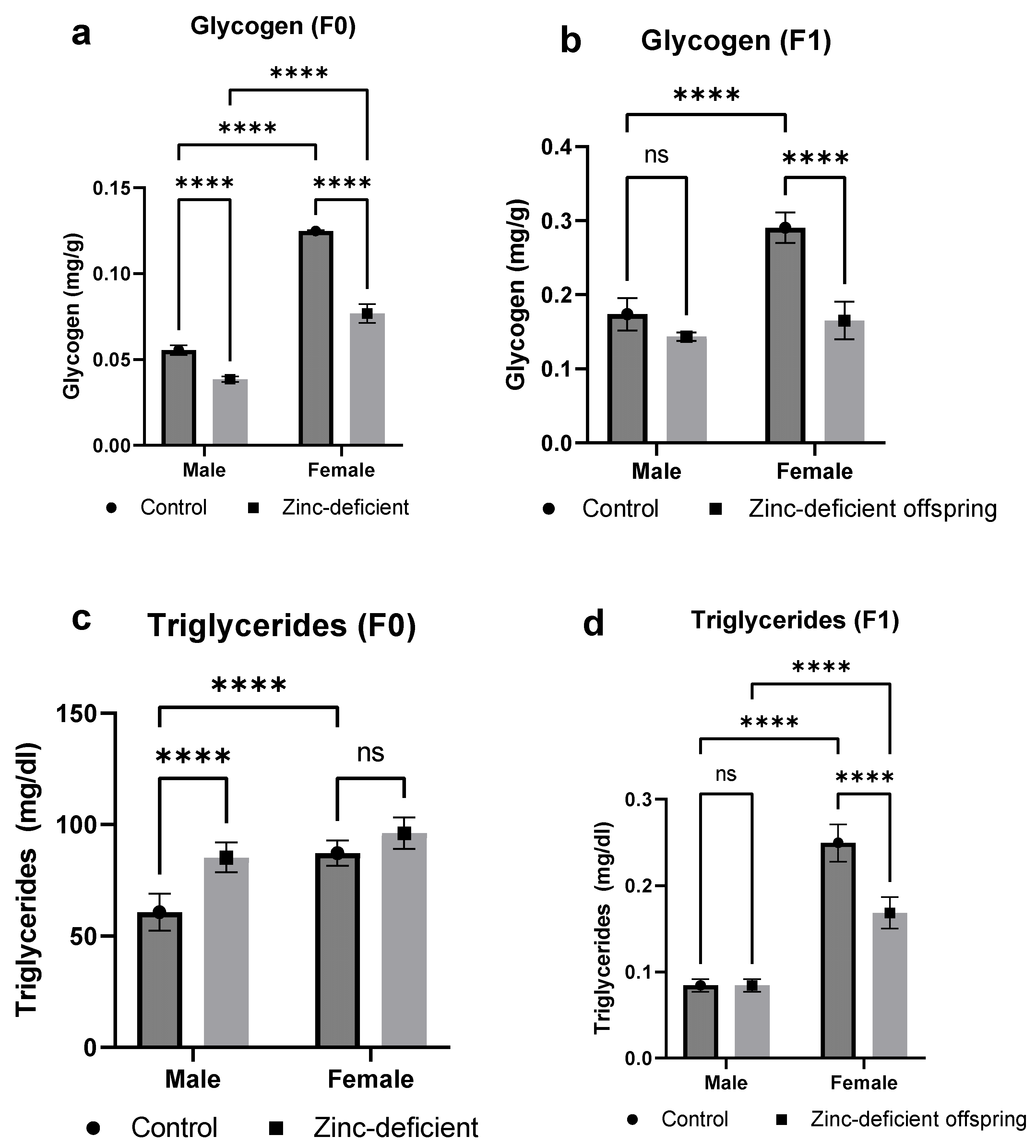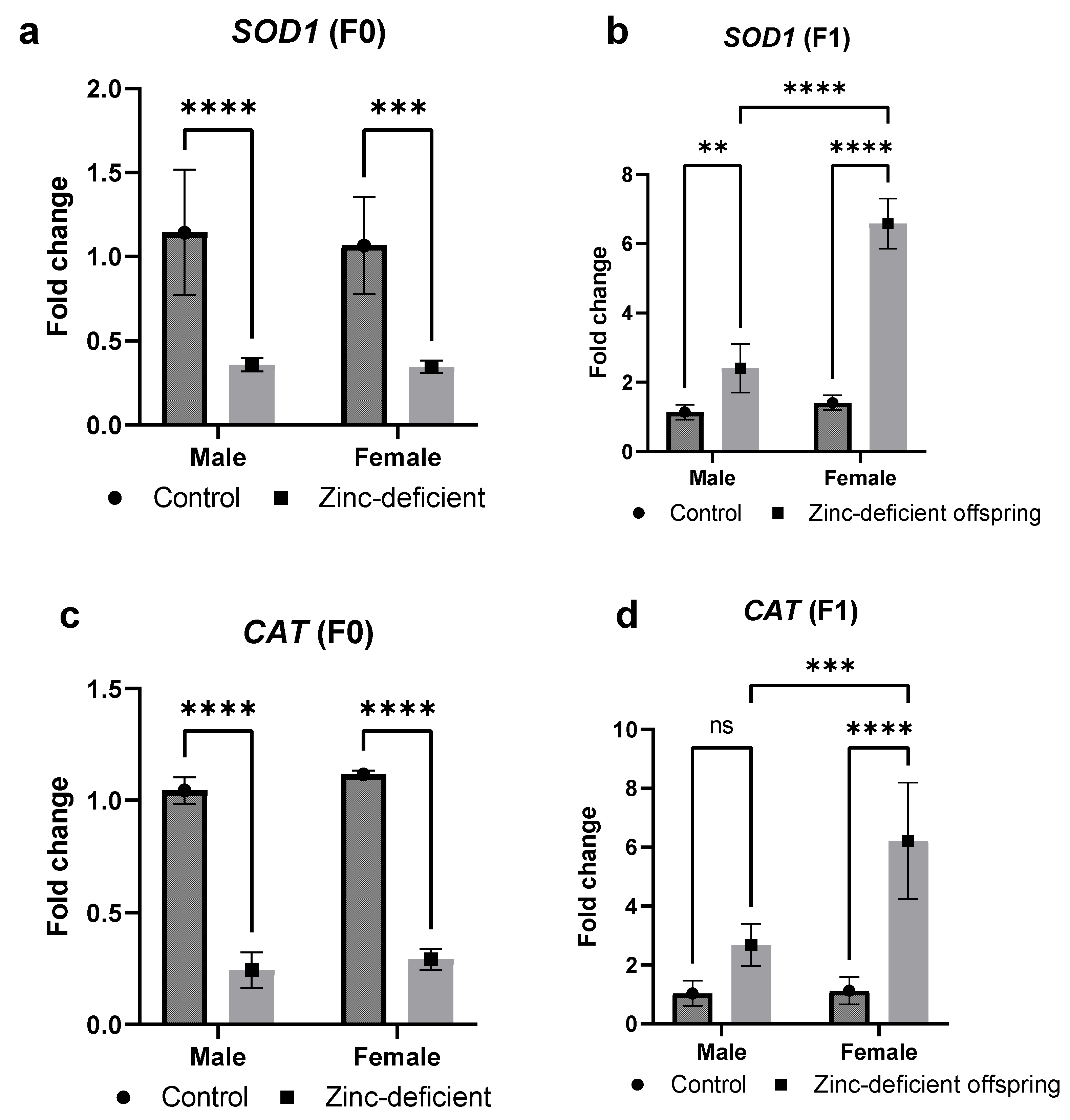Intergenerational Impact of Parental Zinc Deficiency on Metabolic and Redox Outcomes in Drosophila melanogaster
Abstract
Simple Summary
Abstract
1. Introduction
2. Materials and Methods
2.1. Fruit Fly (Drosophila melanogaster) Husbandry and Experimental Design
2.2. Measurement of Total Body Zinc
2.3. Determining Fly Body Weight
2.4. Biochemical Analysis
2.4.1. Sample Preparation
2.4.2. Glucose Assay
2.4.3. Trehalose Assay
2.4.4. Glycogen Assay
2.4.5. Triglyceride Assay
2.4.6. Catalase (CAT) Assay
2.4.7. Total Antioxidant Capacity (TAOC) Assay
2.4.8. Malondialdehyde (MDA) Assay
2.5. Gene Expression Analysis
2.5.1. RNA Extraction
2.5.2. Primer Design
2.5.3. Reverse Transcription Quantitative Polymerase Chain Reaction (RT-qPCR) Analysis
2.6. Statistical Analysis
3. Results
3.1. Effects of Parental Zinc Deficiency on Zinc Levels and Body Weights
3.2. Effects of Parental Zinc Deficiency on Glucose and Trehalose Levels
3.3. Effects of Parental Zinc Deficiency on Glycogen and Triglyceride Levels
3.4. Effects of Parental Zinc Deficiency on Catalase Activities, Total Antioxidant Capacities, and Malondialdehyde Levels
3.5. Effects of Parental Zinc Deficiency on mRNA Levels of Zinc Transporters (dZIP1 and dZnT1) Involved in Zinc Absorption
3.6. Effects of Parental Zinc Deficiency on Zinc Transporter Genes (dZIP71B and dZnT35C) Involved in Zinc Excretion
3.7. Effects of Parental Zinc Deficiency on DILP2 and dPEPCK mRNA Levels
3.8. Effects of Parental Zinc Deficiency on SOD1 and CAT mRNA Levels
3.9. Effects of Parental Zinc Deficiency on EGR and UPD2 mRNA
4. Discussion
5. Conclusions
6. Limitation
Author Contributions
Funding
Institutional Review Board Statement
Informed Consent Statement
Data Availability Statement
Acknowledgments
Conflicts of Interest
References
- Kambe, T.; Tsuji, T.; Hashimoto, A.; Itsumura, N. The Physiological, Biochemical, and Molecular Roles of Zinc Transporters in Zinc Homeostasis and Metabolism. Physiol. Rev. 2015, 95, 749–784. [Google Scholar] [CrossRef]
- Hawrysz, Z.; Woźniacka, A. Zinc: An Undervalued Microelement in Research and Treatment. Postep. Dermatol. I Alergol. 2023, 40, 208–214. [Google Scholar] [CrossRef]
- Roohani, N.; Hurrell, R.; Kelishadi, R.; Schulin, R. Zinc and Its Importance for Human Health: An Integrative Review. J. Res. Med. Sci. 2013, 18, 144–157. [Google Scholar]
- Ejezie, F.; Nwagha, U. Zinc Concentration during Pregnancy and Lactation in Enugu, South-East Nigeria. Ann. Med. Health Sci. Res. 2011, 1, 69–76. [Google Scholar]
- Abregú, F.M.G.; Caniffi, C.; Arranz, C.T.; Tomat, A.L. Impact of Zinc Deficiency During Prenatal and/or Postnatal Life on Cardiovascular and Metabolic Diseases: Experimental and Clinical Evidence. Adv. Nutr. 2022, 13, 833–845. [Google Scholar] [CrossRef]
- Gao, J.; Lv, Z.; Li, C.; Yue, Y.; Zhao, X.; Wang, F.; Guo, Y. Maternal Zinc Supplementation Enhanced Skeletal Muscle Development through Increasing Protein Synthesis and Inhibiting Protein Degradation of Their Offspring. Biol. Trace Elem. Res. 2014, 162, 309–316. [Google Scholar] [CrossRef]
- Hu, Q.; Duncan, F.E.; Nowakowski, A.B.; Antipova, O.A.; Woodruff, T.K.; O’Halloran, T.V.; Wolfner, M.F. Zinc Dynamics during Drosophila oocyte Maturation and Egg Activation. iScience 2020, 23, 101275. [Google Scholar] [CrossRef] [PubMed]
- Strilbytska, O.; Semaniuk, U.; Bubalo, V.; Storey, K.B.; Lushchak, O. Dietary Choice Reshapes Metabolism in Drosophila by Affecting Consumption of Macronutrients. Biomolecules 2022, 12, 1201. [Google Scholar] [CrossRef]
- Abubakar, B.; Usman, D.; Sanusi, K.O.; Azmi, N.H.; Imam, M.U. Preventive epigenetic mechanisms of functional foods for type 2 diabetes. Diabetology 2023, 4, 259–277. [Google Scholar] [CrossRef]
- Sanusi, K.O.; Ibrahim, K.G.; Abubakar, B.; Malami, I.; Bello, M.B.; Imam, M.U.; Abubakar, M.B. Effect of maternal zinc deficiency on offspring health: The epigenetic impact. J. Trace Elem. Med. Biol. 2021, 65, 126731. [Google Scholar] [CrossRef]
- Baltaci, A.; Mogulkoc, R. Leptin and Zinc Relation: In Regulation of Food Intake and Immunity. Indian J. Endocrinol. Metab. 2012, 16, 611. [Google Scholar] [CrossRef]
- Qin, Q.; Wang, X.; Zhou, B. Functional Studies of Drosophila Zinc Transporters Reveal the Mechanism for Dietary Zinc Absorption and Regulation. BMC Biol. 2013, 11, 101. [Google Scholar] [CrossRef]
- Wang, X.; Wu, Y.; Zhou, B. Dietary Zinc Absorption Is Mediated by ZnT1 in Drosophila melanogaster. FASEB J. 2009, 23, 2650–2661. [Google Scholar] [CrossRef]
- Yin, S.; Qin, Q.; Zhou, B. Functional Studies of Drosophila Zinc Transporters Reveal the Mechanism for Zinc Excretion in Malpighian Tubules. BMC Biol. 2017, 15, 12. [Google Scholar] [CrossRef] [PubMed]
- Ranasinghe, P.; Pigera, S.; Galappatthy, P.; Katulanda, P.; Constantine, G.R. Zinc and diabetes mellitus: Understanding molecular mechanisms and clinical implications. DARU J. Pharm. Sci. 2015, 23, 44. [Google Scholar] [CrossRef]
- Olechnowicz, J.; Tinkov, A.; Skalny, A.; Suliburska, J. Zinc status is associated with inflammation, oxidative stress, lipid, and glucose metabolism. J. Physiol. Sci. 2018, 68, 19–31. [Google Scholar] [CrossRef]
- Yamada, T.; Habara, O.; Kubo, H.; Nishimura, T. Fat body glycogen serves as a metabolic safeguard for the maintenance of sugar levels in Drosophila. Development 2018, 145, dev158865. [Google Scholar] [CrossRef] [PubMed]
- Yamada, T.; Habara, O.; Yoshii, Y.; Matsushita, R.; Kubo, H.; Nojima, Y.; Nishimura, T. The role of glycogen in development and adult fitness in Drosophila. Development 2019, 146, dev176149. [Google Scholar] [CrossRef]
- Ranasinghe, P.; Wathurapatha, W.S.; Ishara, M.H.; Jayawardana, R.; Galappatthy, P.; Katulanda, P.; Constantine, G.R. Effects of zinc supplementation on serum lipids: A systematic review and meta-analysis. Nutr. Metab. 2015, 12, 26. [Google Scholar] [CrossRef]
- Semaniuk, U.; Piskovatska, V.; Strilbytska, O.; Strutynska, T.; Burdyliuk, N.; Vaiserman, A.; Bubalo, V.; Storey, K.B.; Lushchak, O. Drosophila Insulin-like Peptides: From Expression to Functions—A Review. Entomol. Exp. Appl. 2021, 169, 195–208. [Google Scholar] [CrossRef]
- Chatterjee, N.; Perrimon, N. What fuels the fly: Energy metabolism in Drosophila and its application to the study of obesity and diabetes. Sci. Adv. 2021, 7, eabg4336. [Google Scholar] [CrossRef] [PubMed]
- Prasad, A.S.; Bao, B. Molecular Mechanisms of Zinc as a pro-Antioxidant Mediator: Clinical Therapeutic Implications. Antioxidants 2019, 8, 164. [Google Scholar] [CrossRef] [PubMed]
- Cordiano, R.; Di Gioacchino, M.; Mangifesta, R.; Panzera, C.; Gangemi, S.; Minciullo, P.L. Malondialdehyde as a potential oxidative stress marker for allergy-oriented diseases: An update. Molecules 2023, 28, 5979. [Google Scholar] [CrossRef] [PubMed]
- Kodra, A.; de la Cova, C.; Gerhold, A.R.; Johnston, L.A. Widely Used Mutants of Eiger, Encoding the Drosophila Tumor Necrosis Factor, Carry Additional Mutations in the NimrodC1 Phagocytosis Receptor. G3 2020, 10, 4707–4712. [Google Scholar] [CrossRef]
- Rajan, A.; Perrimon, N. Drosophila Cytokine Unpaired 2 Regulates Physiological Homeostasis by Remotely Controlling Insulin Secretion. Cell 2012, 2, 123–137. [Google Scholar] [CrossRef]









| S/N | Gene | Primer | Sequence | Annealing Temperature (°C) * |
|---|---|---|---|---|
| 1 | dZIP1 | Forward | AGGCTCAACAACCCTACTTTC | 60 |
| Reverse | TTACCACCCTTGTGTGTTTCT | |||
| 2 | dZnT1 | Forward | CACCATTCAGCCAGAGTTCA | 60 |
| Reverse | CTTCTTCCGTGGTAGGACAATC | |||
| 3 | dZip71B | Forward | CCCAGTAGCCTTCATGGTAATC | 62 |
| Reverse | GCAAAGGCGGTAGCAAATC | |||
| 4 | dZnT35C | Forward | GTGTTGTAACGTGTGGTGTTAG | 62 |
| Reverse | CGTTTGGCAATCGGTGTATC | |||
| 5 | DILP2 | Forward | GTACTCAATTCCCTGGCTGAA | 55 |
| Reverse | CGCAGAGCCTTCATATCACA | |||
| 6 | PEPCK | Forward | TCAATGGCGAATCCTGCTAC | 60 |
| Reverse | CTTCACGTCCACCTTATCCTTC | |||
| 7 | SOD1 | Forward | CGGTCACACCATAGAAGATACC | 65 |
| Reverse | CAGACAGCTTTAACCACCATTTC | |||
| 8 | CAT | Forward | TGGTCGTCTGTTCTCCTACT | 65 |
| Reverse | CCGCTGGAAGTTCTCAATCT | |||
| 9 | UPD2 | Forward | TTGACCATAAACGCCTCCTATC | 60 |
| Reverse | GTGAAAGTTGAGACGCTCCT | |||
| 10 | EGR | Forward | TGAGGCAACTTCCAAAGAGAG | 60 |
| Reverse | CGGATCTGGCTGAAAGAAGAG | |||
| 11 | RPL32 | Forward | GGATCGATTCCTGTGAGAGTTC | 60 |
| Reverse | TGGGCAGTATCCATTGAGTTT |
Disclaimer/Publisher’s Note: The statements, opinions and data contained in all publications are solely those of the individual author(s) and contributor(s) and not of MDPI and/or the editor(s). MDPI and/or the editor(s) disclaim responsibility for any injury to people or property resulting from any ideas, methods, instructions or products referred to in the content. |
© 2024 by the authors. Licensee MDPI, Basel, Switzerland. This article is an open access article distributed under the terms and conditions of the Creative Commons Attribution (CC BY) license (https://creativecommons.org/licenses/by/4.0/).
Share and Cite
Sanusi, K.O.; Ibrahim, K.G.; Abubakar, M.B.; Shinkafi, T.S.; Ishaka, A.; Imam, M.U. Intergenerational Impact of Parental Zinc Deficiency on Metabolic and Redox Outcomes in Drosophila melanogaster. Biology 2024, 13, 401. https://doi.org/10.3390/biology13060401
Sanusi KO, Ibrahim KG, Abubakar MB, Shinkafi TS, Ishaka A, Imam MU. Intergenerational Impact of Parental Zinc Deficiency on Metabolic and Redox Outcomes in Drosophila melanogaster. Biology. 2024; 13(6):401. https://doi.org/10.3390/biology13060401
Chicago/Turabian StyleSanusi, Kamaldeen Olalekan, Kasimu Ghandi Ibrahim, Murtala Bello Abubakar, Tijjani Salihu Shinkafi, Aminu Ishaka, and Mustapha Umar Imam. 2024. "Intergenerational Impact of Parental Zinc Deficiency on Metabolic and Redox Outcomes in Drosophila melanogaster" Biology 13, no. 6: 401. https://doi.org/10.3390/biology13060401
APA StyleSanusi, K. O., Ibrahim, K. G., Abubakar, M. B., Shinkafi, T. S., Ishaka, A., & Imam, M. U. (2024). Intergenerational Impact of Parental Zinc Deficiency on Metabolic and Redox Outcomes in Drosophila melanogaster. Biology, 13(6), 401. https://doi.org/10.3390/biology13060401








